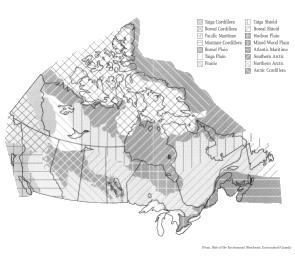
"Me, plus the air, water, minerals, plants, animals and human relationships on which I depend." - Johnny Biosphere, National Geographic, July 1987 |
| Word Power: |
|---|
The word ecosystem combines two words: ecology and system. Eco means habitat or home; system refers to the interdependent way all living and non-living elements of a natural community fit together. A natural ecosystem is very much the same. It includes non-living parts, called abiotic, such as rocks, air, soils and water; and living parts, called biotic, such as plants and animals. The living and non-living elements of an ecosystem are connected through flows of energy and the cycling of chemical elements. |
An ecosystem is a "natural neighbourhood." A human neighbourhood is made up of non-living parts (houses, roads and sewer systems) and living parts (trees, grass, people, dogs, cats and earthworms). Its boundaries are open: people travel to other areas to work, water may be piped in, garbage may be taken elsewhere. It also changes. It may look very different at different times of the year, families move in or out of the neighbourhood, and it can become more or less densely populated.
A forest is a common ecosystem. Forests consist of air, soil, water, nutrients, and particular species of animals, birds, insects, micro-organisms, trees, and other plant life. If some of the trees are cut down, each of the other elements will be affected. Animals and birds may lose their habitats, soil may erode, nutrients may be displaced and the flow of waterways may change.
The biggest ecosystem is the biosphere: the surface of the Earth, the oceans and the atmosphere and all life on the planet. The biosphere is also sometimes called the ecosphere. A continent, a forest, the Great Lakes, local ponds and woodlots... these are all ecosystems that have biotic elements which depend on each other and the abiotic elements they need to survive.
Imagine a photograph of the biosphere or ecosphere taken from outer space. What if you were out there focusing in on the Earth through powerful binoculars? What would you see? All around the ecosphere, you’d find the next largest ecosystems: oceans and continents. Zooming still closer, you’d notice regional ecosystems like rain forests, sea coasts, lakes, rivers, mountains, prairies and tundra. An even closer look would reveal natural communities like wildflower meadows, marshes, creeks and woodlots plus human communities, such as farms, cities, towns and suburbs. And nestled right in the middle of one of these human communities, you’d spot your very own ecosystem.
Canada is divided into 15 ecozones, based on a wide range of characteristics, such as climate, soils, water, vegetation and animals. Scientists developed an Ecological Classification System to help us to understand the huge variety of ecosystems in Canada. The classification system takes the 15 ecozones and divides them further into 47 ecoprovinces, 217 ecoregions, 5,395 ecodistricts and so on.

Today, not just single species, but entire ecosystems are at risk. There are more kinds of ecosystems in Canada than you can imagine, from tall-grass prairies and estuaries to Carolinian forests and alpine meadows. Each contains a unique collection of living things - some found nowhere else on the Earth, and has its own unique life-supporting conditions.
When areas are polluted, ploughed or paved over, the wildlife that depend on them often have nowhere else to live. Even though it may be possible to restore some polluted sites to health and help logged forests regenerate, they will never be exactly as they were; that would require replacing all the original species they once supported. We must protect ecosystems because, without a variety of spaces for wildlife, we can’t conserve the incredible variety of species that live in them.
It may be possible to rehabilitate a degraded ecosystem either by letting nature "take its course" or through active reclamation efforts. It’s cheaper to prevent damage than to fix it, assuming it can be fixed. Estimates place the cost of preventing damage at about 10 percent of what it costs to fix it. For example, re-establishing and maintaining the Great Lakes basin ecosystem will cost tens of billions of dollars. Anticipating and preventing the pollution would have been cheaper, as well as better for the environment. And, of course, some damage, such as the loss of a species, can never be undone.
Imagine placing a single green plant in a glass jar with air, water, soil and light from the sun. The plant could make its own food through photosynthesis (from water, carbon dioxide and light). But eventually the plant would die as it used up all of the nutrients in the soil. It would die because it couldn’t recycle the materials it needs to live; no green plant can decompose its own products into the inorganic compounds necessary for plant life.
In fact, no single organism, population or species is able to produce all of its own food and recycle all of its metabolic products. Life requires the interaction of several species in an environment that includes air and/or water to transport materials and energy. This is one of the fundamental principles of ecology; sustained life is a property of ecosystems, not of organisms or species.
Everything is related to everything else.